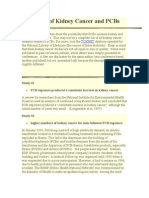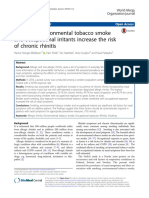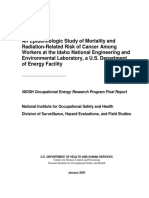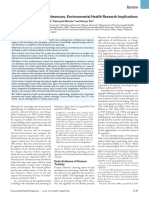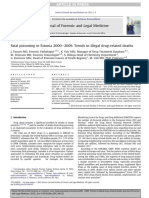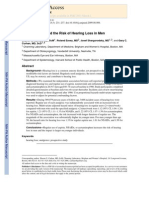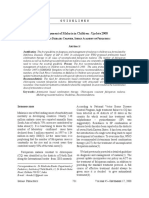Epidemiology: American Journal of
Epidemiology: American Journal of
Uploaded by
Riska FerdianCopyright:
Available Formats
Epidemiology: American Journal of
Epidemiology: American Journal of
Uploaded by
Riska FerdianOriginal Title
Copyright
Available Formats
Share this document
Did you find this document useful?
Is this content inappropriate?
Copyright:
Available Formats
Epidemiology: American Journal of
Epidemiology: American Journal of
Uploaded by
Riska FerdianCopyright:
Available Formats
American Journal of
EPIDEMIOLOGY
Volume 144 Number 7 October 1, 1996 Copyright 1996 by The Johns Hopkins University School of Hygiene and Public Health Sponsored by the Society for Epidemiologic Research
ORIGINAL CONTRIBUTIONS Exposure to Styrene and Mortality from Nervous System Diseases and Mental Disorders
Esther Welp, 12 Manolis Kogevinas,1'3 Aage Andersen,4 Tom Bellander,66 Marco Biocca,7 David Coggon, 8 Jacques Esteve,1 Valerio Gennaro,9 Henrik Kolstad, 10 Ingvar Lundberg,5 Elsebeth Lynge,11 Timo Partanen,1'12 Alan Spence,13 Paolo Boffetta,1 Gilles Ferro,1 and Rodolfo Saracci -14 Chronic low-dose exposure to solvents has been associated in epidemiologic studies with chronic neurotoxictty, but the evidence is not consistent. Styrene causes acute disturbances in the central and peripheral nervous systems. To determine if exposure to styrene may contribute to chronic diseases of the central nervous system, the authors examined mortality from nervous system diseases, mental disorders, and suicide in relation to styrene exposure in an international historical cohort study. The cohort involved 35,443 workers employed during 1945-1991 in the reinforced plastics industry, where high exposures to styrene occur. Indicators of exposure were reconstructed through job histories and environmental and biologic monitoring data Poisson regression was used for internal comparisons. Mortality from diseases of the central nervous system (27 deaths) increased with time since first exposure, duration of exposure, average level of exposure, and cumulative exposure to styrene. A quadratic model described best the dose-response shape for cumulative exposure and duration of exposure with the highest risks at around 300 ppm-years and 5 years, respectively, and a subsequent decrease in risk in the highest exposure categories. Mortality from epilepsy increased monotonically with all styrene exposure indicators, while associations for degenerative diseases of the central nervous system were generally weaker. Mortality from mental disorders and suicide decreased with increasing duration of exposure and cumulative exposure, while there was no trend with time since first exposure and average exposure to styrene. These findings suggest that, in addition to the known acute effects, exposure to styrene may contribute to chronic diseases of the central nervous system. Am J Epidemiol 1996; 144:623-33. central nervous system; cohort studies; mental disorders; mortality; occupational health; styrenes; suicide
Downloaded from http://aje.oxfordjournals.org/ by guest on December 22, 2011
Styrene (C 8 H 8 , Chemical Abstracts Service Registry number 100-42-5) is an aromatic hydrocarbon
Received for publication September 5, 1995, and accepted for publication May 21, 1996. Abbreviations: Cl, confidence interval; ICD-9, International Classification of Diseases, Ninth Revision; RR, rate ratio; SMR, standardized mortality ratio. 1 Unit of Environmental Cancer Epidemiology, International Agency for Research on Cancer, Lyon, France. 2 Department of Environmental Health, University of Washington, Seattle, WA. 3 Department of Epidemiology and Public Health, Instftut Municipal d'lnvestlgaci6 Medica, Barcelona, Spain. * The Cancer Registry of Norway, Oslo, Norway. 5 Department of Occupational Health, Karolinska Hospital, Stockholm, Sweden. 9 Center for the Study and Prevention of Cancer, Florence, Italy.
produced in large quantities throughout the world. Global production of styrene in 1992 was over
Centra dl Documentazione per la Salute, Bologna, Italy. Medical Research Council Environmental Epidemiology Unit, University of Southampton, Southampton, United Kingdom. 8 Istttuto Nazionale per la Rlcerca sul Cancro, Genova, Italy. 10 Institute of Epidemiology and Social Medicine, University of Aarhus, Aarhus, Denmark. 11 Danish Cancer Society, Copenhagen, Denmark. 12 Finnish Institute of Occupational Health, Helsinki, Finland. 13 Epidemiology and Medical Statistics Unit, Health and Safety Executive, Bootle, United Kingdom. 14 Instituto Rsiologia Clinica, Pisa, Italy. Reprint requests to Dr. M. Kogevinas, Department of Epidemiology and Public Health, Institut Municipal d'lnvestigacio Medica (IMIM), 80 Doctor Aiguader Rd., Barcelona 08003, Spain.
8 7
623
624
Welp et al.
14,000 tons (906 kg) (1). The major uses for styrene are in the manufacture of plastics, latex paints and coatings, synthetic rubbers, polyesters, and styrenealkyd coatings (2). Exposure occurs primarily in the workplace: during the production and polymerization of styrene; manufacture of plastics, resins, and synthetic rubber; and fabrication of products such as boats and containers made from glass-reinforced plastics (1). Styrene is taken up through the lung (3) and to a lesser extent through the skin (4). It exhibits lowto-moderate acute toxicity in various organs in laboratory animals (5). In humans, it causes irritation of the skin, eyes, throat, and the respiratory tract and acute disturbances of the central and peripheral nervous system. A wide spectrum of barely detectable to severe adverse acute neurologic effects of occupational styrene exposure have been reported, such as decreased nerve conduction velocities and electroencephalographic, functional, and psychiatric impairments (6-11). Most neurologic effects have been observed at levels of about 100 ppm of styrene, although memory and neurobehavioral disturbances were seen at levels of 10-30 ppm and above. The underlying mechanism of styrene-induced neurotoxicity remains undetermined. Depletion of brain dopamine levels has been proposed as a potential mechanism of neurotoxicity (12). Styrene, like other solvents, has also been associated with chronic neurotoxicity (6, 7, 11, 13-16), but the evidence is not consistent. A full-blown clinical neurotoxic disease from long-term occupational exposure to styrene is seldom encountered or, at least, very rarely diagnosed. Chronic low-dose exposure to various solvents has been associated in epidemiologic studies with chronic neurotoxicity, but the evidence is not entirely consistent and the biologic mechanism is unknown (17-21). We have previously reported the patterns of cancer mortality in an international cohort of workers exposed to styrene in the reinforced plastics industry (22-24), as well as mortality from other causes of death in one of the national cohorts (25). The international cohort, with well-characterized heavy exposure to styrene, offers an opportunity to explore the relation of solvent exposure to neuropsychiatric diseases. This paper examines mortality from diseases of the nervous system, mental disorders, and suicide in the same cohort.
MATERIALS AND METHODS Subjects
products during 1945-1991. These cohort members were identified through eight research centers in six countries (Denmark, Finland, Italy (two centers), Norway, Sweden, United Kingdom (two centers)). Because of unknown date of birth, unknown date of first employment, or unknown sex, 479 workers were subsequently excluded. In this analysis, we also excluded those unexposed to styrene or whose exposure was unknown (n = 5,245). Unexposed workers were excluded because they did not constitute a valid reference group for the international study, since in three centers (Denmark, Finland, United Kingdom (center 2)) information was only abstracted for exposed workers. The remaining 35,443 exposed workers comprised 30,682 men and 4,761 women ever employed in the reinforced plastics industry. For internal comparisons, we further excluded 2,641 exposed subjects with incomplete information on duration of exposure. This left 32,802 exposed subjects for the Poisson regression analysis. A detailed description of recruitment to the cohort has been reported elsewhere (23). Information on employment was abstracted from company payrolls in five countries and from national pension scheme records in Denmark. Three categories of workers were distinguished on the basis of exposure measurements and job titles: 1) laminators (n = 10,629); 2) workers with "unspecified tasks" including predominantly workers with laminating tasks (n = 19,408); and 3) workers in "other exposed jobs" (n 5,406). The follow-up for mortality started at the first exposure to styrene or on the first date for which complete payrolls were available in the plant if later. The cohort members accumulated 446,784 person-years during an average of 12.6 years of follow-up (table 1). Workers lost to follow-up constituted 1.4 percent of the total cohort and those emigrated, 1.6 percent. In no national component did the proportion of workers lost to follow-up or emigrated exceed 8 percent. The cohort of 32,802 exposed subjects included in internal comparisons accumulated 405,975 person-years during an average of 12.4 years of follow-up.
Exposure assessment
Downloaded from http://aje.oxfordjournals.org/ by guest on December 22, 2011
The original cohort comprised 41,167 subjects employed in 660 plants manufacturing reinforced plastics
A styrene exposure database was constructed on the basis of some 16,500 personal exposure measurements conducted during the period 1955-1990 and around 18,500 determinations of styrene metabolites in urine, conducted in the late 1980s (23, 26). Exposure decreased in all countries from recorded levels of around 200 ppm in the 1960s to levels of 20-40 ppm in the late 1980s (figure 1). Extensive exposure information for early periods of production (before 1970) was available for Denmark only (27). Exposures in early
Am J Epidemiol Vol. 144, No. 7, 1996
Central Nervous System Mortality and Styrene Exposure
625
TABLE 1.
Description of exposed workers hi the International cohort Ma of plants 287 157 3 98 26 30 8 51 660 Men (no.) 13,682 1,652 1,106 2,952 1,690 2,787 5,064 1,749 30,682 Women (no.) 2,185 433 60 1,253 238 534 58 4,761 Person-years 175,640 30,726 13,847 35,873 20,607 42,599 105,538 27,164 451,993 Period of follow-up 1970-1990 1958-1989 1969-1991 1956-1989 1956-1991 1955-1987 1945-1990 1961-1988
Country and research canter Denmark Finland Italy Center 1 Center 2 Norway Sweden United Kingdom Center 1 Center 2 Total
production periods in the remaining five countries were estimated using national exposure data in conjunction with the exposure levels recorded in Denmark. The use of Danish data for the international cohort is justified by the similar production processes and materials used in plants under study, the similarity in time trends for exposure to styrene between countries after 1970, and limited information available for a few measurements that had been carried out in other countries before 1970 (28) (B. Pannett, Medical Research Council, Southampton, United Kingdom, personal communication, 1994). An exposure matrix was constructed by country and calendar period on job title, type of products, and methods of production.
Estimates of individual exposure were reconstructed by aggregating this matrix and personal occupational histories.
Statistical analysis
Downloaded from http://aje.oxfordjournals.org/ by guest on December 22, 2011
For external comparisons, standardized mortality ratios were calculated with 95 percent confidence intervals based on the Poisson distribution, using the PERSONYEARS program (29). The World Health Organization mortality data bank was used to compute national mortality rates by sex, age (in 5-year groups), and calendar period (in 5-year periods, except when periods coincided with a revision of the International
240 -
1960
1965
1970 1975 1980 Calendar period
1985
1990
FIGURE 1. Recorded levels of exposure to styrene by calendar period among laminators in the reinforced plastics industry In an international cohort between 1960 and 1990. , Denmark; +, Finland; *, Italy; , Norway; x , Sweden; , United Kingdom.
Am J Epidemiol
Vol. 144, No. 7, 1996
626
Welp et al.
Classification of Diseases) from which expected numbers of death were derived. The list of diseases for which standardized mortality ratios could be calculated was limited by the availability of mortality rates in the World Health Organization data bank for the follow-up period. The underlying cause of death for deceased cohort members was retrieved from the national death certificate records. For internal comparisons, calculation of exposure indices and allocation of person-years to the relevant exposure/confounder categories were performed using a SAS program (30). Country, sex, age (five levels: <35, 35-44, 45-54, 55-64, and >65 years), and calendar period (four levels: <1975, 1975-1979, 1980-1984, >1985) were included in all models as possible confounders. The time since first exposure was categorized in three levels (<10, 10-19, >20 years). Cumulative exposure (ppm-years) and average exposure (ppm, calculated as cumulative exposure divided by total duration of exposure) were derived and categorized. The cutpoints for cumulative (eight levels) and average (four levels) exposure and for duration of exposure (eight levels) were chosen a priori to give an even spread of the number of deaths across levels ensuring, however, that there was at least one death in each category. Poisson regression models were used for the internal comparisons among exposed subjects, and rate ratios and 95 percent confidence intervals were estimated for a more detailed list of diseases than was feasible when using external reference rates. Tests for linear trend were performed by
entering an exposure term as a continuous variable into the model and comparing the deviance of the model before and after introducing the variable. The shape of the dose-response for duration of exposure and cumulative exposure was examined using spline regression models (31) on grouped data, with values in each category equal to their rank. First, a linear and a quadratic term were fitted. A second quadratic term was then added with the knot chosen at the maximum in the analysis of eight categories, that is, at category 5 for cumulative exposure (200-349 ppm-years) and category 6 (7-9 years) for duration (see table 3 and figure 2). The GLIM statistical package (32) was used for the analysis.
RESULTS
Downloaded from http://aje.oxfordjournals.org/ by guest on December 22, 2011
External comparisons
Mortality from all causes in the total cohort (n 40,688) was lower than expected from national rates (2,714 observed deaths, standardized mortality ratio (SMR) = 0.92, 95 percent confidence interval (CI) 0.88-0.95). In exposed workers (n = 35,443) (table 2), there was a slight deficit (2,196 deaths, SMR = 0.96), due mainly to low mortality from malignant neoplasms (550 deaths, SMR = 0.91), respiratory diseases (118 deaths, SMR = 0.81), and circulatory diseases (874 deaths, SMR = 0.95). Mortality from mental disorders was around that expected (21 deaths, SMR = 1.01) and, from peripheral and central nervous system diseases, lower than expected (30 deaths,
0-24
25-49
50-74
75-199
200-349
350-499
500-749
750+
Cumulative exposure (ppm-years)
FIGURE 2. Log rate ratios for mortality from central nervous system diseases by cumulative exposure to styrene among international cohorts from 1945 to 1991. Categorical Poisson regression (dots, with bars indicating 95 percent confidence intervals), quadratic regression (solid line), and quadratic spline regression (dashed line). All models are adjusted for country, age, calendar year, and sex.
Am J Epidemiol
Vol. 144, No. 7, 1996
Central Nervous System Mortality and Styrene Exposure
627
TABLE 2. Standardized mortality ratios by detailed cause of death for exposed woricera in the International cohort, 1946-1991
Cause of death by ICD-9* codes No. of observed deaths No. of expected deaths SMR' 95% Cl*
All causes (codes 001-999) All malignant neoplasms (codes 140-208) Mental disorders (codes 290-319) Diseases of nervous system (codes 320-389) Diseases of circulatory system (codes 390-459) Cerebfovascular diseases (codes 430-438) Diseases of respiratory system (codes 460-619) Diseases of digestive system (codes 520-579) External causes of death (E800-E999) Suicide and seH-lnfllcted Injury (E950-E959) Other violent causes (E800-E918, E921-E949, E960-E999)
2,196 550 21 30 874 121 118 70 365 136 224
2,293.1 607.3 20.9 39.4 920.1 144.9 146.5 89.4 323.1 123.4 192.0
0.96 0.91 1.01 0.76 0.95 0.84 0.81 0.78 1.13 1.10 1.17
0.92-1.00 0.83-0.98 0.62-1.54 0.51-1.09 0.89-1.08 0.69-1.00 0.67-0.96 0.61-0.99 1.02-1.25 0.92-1.30 1.02-1.33
* ICD-9, International Classification of Diseases, Ninth Revision; SMR, standardized mortality ratio; Cl, confidence interval. Downloaded from http://aje.oxfordjournals.org/ by guest on December 22, 2011
SMR = 0.76). Accidents, poisoning, and violence constituted the only major category with a significantly raised standardized mortality ratio (365 deaths, SMR = 1.13), due to an excess of suicides and selfinflicted injuries (136 deaths, SMR = 1.10) and of deaths from other violent causes (224 deaths, SMR = 1.17).
Internal comparisons
The mortality from central nervous system diseases (table 3) increased with average exposure to styrene (p value for trend = 0.37), cumulative exposure (p value for trend = 0.01), duration of exposure (p value for trend = 0.02), and time since first exposure (p value for trend = 0.32). Workers with an average exposure higher than 120 ppm had an almost twofold risk compared with workers whose average exposure was less than 60 ppm, and those with a cumulative exposure of more than 75 ppm-years had risks ranging from six- to 16-fold compared with workers with less than 24 ppm-years. Adjustment for the time since first exposure did not materially affect the rate ratios for cumulative exposure and duration but reduced the rate ratios for average exposure (rate ratio (RR) = 1 . 0 for <60 ppm of styrene; RR = 1 . 1 for 60-119 ppm; and RR = 1.5 for 120 ppm). The shape of the dose-response for the duration of exposure and cumulative exposure was examined witji spline regression models (figure 2). A first model included a linear and a quadratic term for both duration and cumulative exposure. For both variables, the linear and quadratic terms were above or close to statistical significance. The beta coefficients for duration were 1.091 0.4193 (standard error) for the linear term and -0.1022 0.0488 for the quadratic term. The corresponding values for cumulative exposure were 1.348 0.435 and -0.1196 0.0444.
Am J Epidemiol Vol. 144, No. 7, 1996
This simple quadratic equation fitted the data adequately, and the addition of a spline with one knot at the maximum (figure 2) did not improve the fit for cumulative exposure (difference in deviance, 0.2267, 1 df) or for duration (difference in deviance, -0.0022, 1 df). Deaths from epilepsy constituted a quarter of all deaths from central nervous system diseases (table 4). This proportion is about that expected on the basis of national mortality statistics. No deaths from diseases of the peripheral nervous system were recorded. Mortality from epilepsy increased monotonically with all exposure indicators (table 5), but confidence intervals were wide because of small numbers. Of the seven deaths from epilepsy, six (86 percent) occurred below the age of 35 years. Two deaths from epilepsy occurred while the subjects were employed in the reinforced plastics industry or within half a year after having left the industry. Four subjects succumbed between half a year and 5 years after termination of employment. Mortality from degenerative diseases of the central nervous system (cerebral degenerations, not in childhood, International Classification of Diseases (ICD-9) code 331; Parkinson's disease, ICD-9 code 332; and anterior horn cell disease, ICD-9 code 335) did not increase consistently with increasing exposure to styrene (table 5), although mortality tended to be higher among workers with a long duration of exposure or high cumulative exposure. Workers with higher than 200 ppm-years of cumulative exposure had an approximately fourfold statistically significant increased risk compared with workers with less than 200 ppm-years. Of 11 deceased subjects in this category, seven were diagnosed with anterior horn cell disease, which typically comprises mostly patients with amyotrophic lat-
628
Welp et al.
TABLE 3. Mortality from central nervous system diseases* bi the International cohort, 1945-1991, and indices of exposure to styrenef No. of deaths Time since first exposure (years) <10 10-19 20 Duration of exposure 0-5 months 6-11 months 1-2.4 years 2.5-3 years 4-6 years 7-9 years 10-14 years ^15 years Average exposure (ppm) <60 60-119 120 Cumulative exposure (ppm-years) 0-24 25-49 50-74 75-199 200-349 350-499 500-749 750 9 14 4 RR$ 1.00 1.98 1.68 95% Of p tor linear trend 0.32 0.73-5.35 0.39-7.24
3 2 7 3 5 4 2 1
1.00 2.33 4.97 5.00 6.46 8.80 4.75 4.08
0.02 0.40-13.56 1.29-19.15 1.01-24.69 1.50-27.78 1.87-41.33 0.75-30.14 0.39-43.13
9 10 8
1.00 1.31 1.72
0.37 0.50-3.42 0.57-5.13
Downloaded from http://aje.oxfordjournals.org/ by guest on December 22, 2011
2 2 1 5 9 2 3 3
1.00 3.29 1.42 7.14 16.32 5.90 8.55 5.40
0.01 0.48-22.65 0.14-14.35 1.39-36.59 3.47-76.73 0.82-^2.69 1.36-53.68 0.83-35.06
* International Classification of Diseases, Ninth Revision, codes 320-389. Occupational history (duration of exposure) was Incomplete for three additional deceased exposed subjects. t Internal comparisons (Poisson regression analysis), all models being adjusted for country, age, calendar year, and sex. t RR, rate ratio; Cl, confidence interval.
TABLE 4. Underlying causes of death from central nervous system diseases In exposed workers In the International cohort, 1945-1991 Cause of death by ICD-9* code No. of deaths Meningitis (code 320) 3 Irrtracranlal and intraspinal abscess (code 324) 1 Cerebral degenerations, not In childhood (code 331) 1 Parkinson's disease (code 332) 3 Anterior horn cell disease (code 335) 7 Epilepsy (code 345) 7 Other conditions of brain (code 348) 4 Other disorders of nervous system (code 349) 1 All 27 ICD-9, International Classification of Diseases, Ninth Revision.
eral sclerosis. Mortality from amyotrophic lateral sclerosis was not consistently associated with exposure, although the risk tended to increase with cumulative exposure (RR = 1.0 for <50 ppm-years, referent category; RR = 3.14, 95 percent CI 0.39-25.5, for 50-199 ppm-years; RR = 6.90, 95 percent CI 0.9251.8, for 200-499 ppm-years; RR = 2.47, 95 percent CI 0.21-29.11, for >500 ppm-years; p value for trend,
0.29) and was highest in the longest duration category (RR = 6.69, 95 percent CI 0.53-85.08 for >10 years of duration). We also examined mortality from cerebrovascular diseases (ICD-9 codes 430-438), since this group of diseases may be of relevance when examining mortality from central nervous system diseases. A small but statistically significant increase in mortality from cerebrovascular diseases was observed by the time since first exposure (p value for trend = 0.0042) and with average exposure (p value for trend = 0.013). No trend in risk was seen for the duration of exposure or cumulative exposure (table 6). The mortality from mental disorders, in particular from psychosis (seven deaths) and neurotic disorders (12 deaths), was highest among short-term workers (< 1 year of employment) and decreased with increasing duration of employment (table 7). A similar pattern was seen for suicide, with a clearly higher risk among workers with a short duration of exposure (RR = 1.0 for <1 year of duration; 0.42 for 1-3 years; 0.31 for 4-9 years; and 0.44 for >10 years). For all
Am J Epidemiol Vol. 144, No. 7, 1996
Central Nervous System Mortality and Styrene Exposure
629
TABLE 5. Mortality from epilepsy* and degenerative central nervous system diseases In the International cohort, 1945-1991, and Indices of exposure to styrenef
Eptepsy No. of deaths Degenerative central nervous system diseases P for trend No. of deaths
RR*
95% Cl*
RR
95% Cl
P tor trend
Time since first exposure (years) 10-19 20 Duration of exposure (years) 1-3 4-9 10 Average exposure (ppm) <60 60-119 120 Cumulative exposure (ppm-years) <50 50-199 200-^99 500 1 3 1 2 1.00 1.37 8.26 28.4 0.03 0.08-23.2 0.76-90.4 2.11-381.5 1 5 4 1 1.00 8.85 9.88 4.74 0.16 1.06-73.9 1.09-89.9 0.28-79.8 3 3 1 1.00 5.64 485.9 0.008 1.03-30.9 1.19-9,999 3 5 3 1.00 1.02 1.22 0.75 0.20-5.15 0.16-9.19
* Epilepsy; Intemationar Classification of Diseases, Ninth Revision (ICD-9), code 345; degenerative central nervous system diseases: ICD-9 codes 331, 332, and 335. t Internal comparisons (Poisson regression analysis), all models being adjusted for country, age, calendar year, and sax. $ RR, rate ratio; Cl, confidence interval.
these causes of death, the pattern for the other exposure indices was similar: no trend for the time since first exposure or average exposure, with the highest risk associated with the lowest cumulative exposure. The pattern of risk for traffic accidents was similar to that observed for suicide with the highest risk among short-term workers (RR = 1.0 for < 1 year of duration; 0.55 for 1-3 years; 0.39 for 4-9 years; and 0.37 for >10 years). Of the 27 deaths from central nervous system diseases, 13 occurred in the Danish cohort. The pattern of risk for central nervous system diseases by time since first exposure, duration of exposure, and cumulative exposure was fairly similar between the Danish and the cohorts in the other five countries. An inconsistently increasing risk by average exposure was observed in Denmark, while there was no increase in the other five countries.
DISCUSSION
This historical cohort study of workers exposed to styrene was initially formed to examine the risk of leukemia and lymphoma. Very little information is available, however, on mortality from other diseases associated with exposure to styrene, despite the fact that acute and chronic exposures to the compound
Am J Epidemiol Vol. 144, No. 7, 1996
CO CM CM
1.00 1.20 3.35
0.32 0.16-9.21 0.32-35.4
4 2 5
1.00 0.43 1.30
0.32 0.07-2.44 0.31-5.42 Downloaded from http://aje.oxfordjournals.org/ by guest on December 22, 2011
1 2 2 2
1.00 2.95 5.33 9.63
0.07 0.25-34.3 0.44-64.9 0.71-131.1
1 2 7 1
1.00 3.09 14.4 1.87
0.16 0.28-33.8 1.75-119.2 0.11-31.1
have been shown to affect physiologic parameters and cause morbidity in various systems. Chronic low-dose exposure to various solvents has been associated with neurotoxicity, but the epidemiologic evidence is not consistent (17-20). The validity of some of the findings has been questioned, particularly concerning the definition of the disease and of the exposure, the lack of specificity of the effects, the lack of dose-response relations, and the absence of a biologically plausible mechanism (21). In this international study, the exposure to solvents and the outcome were well characterized, and positive dose-response relations were observed. Inaccuracy of diagnoses from death certificates, confounding by other chemical exposures in the workplace, and a biased comparison group particularly due to the healthy worker effect may, however, have influenced the validity of our results. We discuss these issues in turn. Erroneous diagnoses or coding of death certificates may have affected analyses for specific diseases within the wider category of central nervous system diseases. This is reflected, for example, in the relatively high number of deaths ( = 5) coded as other conditions/disorders of the nervous system (table 4). All effect estimates were adjusted for calendar period and country, and this should, at least, reduce any errors
630
Welp et al.
TABLE 6. Mortality from cerebrovascular diseases* In the International cohort, 1945-1991, and Indices of exposure to styrenef No. of deaths Time since first exposure (years) 10-19 20 Duration of exposure (years) 1-3 4-9 49 21 26 14 1.00 0.65 0.95 0.82 0.75 0.39-1.08 0.57-1.57 0.43-1.55 27 52 31 1.00 1.71 2.66
0.0042
RR*
95% C l *
p for trend
1.01-2.91 1.37-5.15
Average exposure (ppm) <20 20-59 60-119 120-199 200 Cumulative exposure (ppm-years) 10-74 75-199 200-^99 500
4 20 38 30 18
1.00 1.08 1.38 2.11 2.15
0.013 0.37-3.19 0.48-3.95 0.72-6.18 0.70-6.62
Downloaded from http://aje.oxfordjournals.org/ by guest on December 22, 2011
20 22 21 19 28
1.00 0.68 0.84 0.69 0.77
0.57 0.37-1.24 0.45-1.57 0.36-1.30 0.42-1.42
International Classification of Diseases, Ninth Revision, codes 430-438. Occupational history (duration of exposure) was incomplete for 11 additional deceased exposed subjects. t Internal comparisons (Poisson regression analysis), all models being adjusted for country, age, calendar year, and sex. $ RR, rate ratio; Cl, confidence Interval.
due to temporal variation in coding or diagnostic practices, as well as differences among countries. An associated issue is possible misdiagnosis between diseases of the central nervous system and cerebrovascular diseases. Mortality from cerebrovascular diseases was not associated with cumulative exposure or duration of exposure, and consequently it is unlikely that the positive trends observed for central nervous system diseases are due to a transfer of diagnoses between the two disease groups. Among the industries using styrene, manufacture of reinforced plastics involves by far the highest recorded levels of exposure to the chemical (26-28). Acetone and glass fiber are among other agents used in large quantities in this industry. Also used, although in much lower quantities, are various other solvents including agents with known or suspected neurotoxicity, such as toluene, n-hexane, and gasoline (27). A confounding effect of such solvents cannot be ruled out, although given the relatively low levels of exposure, we would expect any such effect to be small. The healthy worker effect is of special relevance in this study, since many neurologic deaths follow chronic disabling disease. Selection of healthy individuals into employment affects predominantly external comparisons using national mortality rates as the
reference and may have contributed to the low standardized mortality ratios observed in this study for central nervous system diseases. This type of bias should not affect internal comparisons within the cohort. Decline of health status with time may lead to an increase in risk with time since first exposure (as observed in this cohort) but also may affect the results by duration of exposure and cumulative exposure. Selection out of employment of ill individuals was potentially a more important problem in the internal comparisons in this study because of the prolonged duration of central nervous system diseases. This aspect of the healthy worker effect tends to attenuate dose-response relations. Thus, the increased mortality from central nervous system diseases in this study with exposure to styrene indicates that, if anything, the association between styrene and central nervous system mortality may be even stronger than suggested in our analysis. The nervous system has been shown to be one of the most sensitive target systems for styrene. Epilepsy was among the most frequent causes of death from central nervous system diseases in this population and was positively associated with all exposure indicators in the internal comparisons. Case reports and epidemiologic studies of workers exposed to organic solvents
Am J Epidemiol Vol. 144, No. 7, 1996
Central Nervous System Mortality and Styrene Exposure
631
TABLE 7. Mortality from mental disorders and suicide In the international cohort, 1945-1991, by duration of exposure to styrene (in years)* No. of deaths Duration of exposure (years) 1-3 4-9 10 Duration of exposure (years) 14 3 1.00 0.37 0.16 0.22 0.10-1.31 0.02-1.26 0.02-1.89 RRf 95%Clt p tor trend 0.01
Mental disorders (ICD-9\ codes 290-319)
1 1
Psychosis (ICD-9 codes 290-299) 1.00 0.94 0.48 0.56 Neurotic disorders (ICD-9 codes 300-316) Duration of exposure (years) 11 1 Duration of exposure (years) 1-3 4-9 10 95 22 1.00 0.42 0.31 0.44 <0.001 1.00 0.10 Downloaded from http://aje.oxfordjournals.org/ by guest on December 22, 2011 0.01-0.78 0.48 0.15-5.80 0.05-4.91 0.05-6.58
1-3 4-9
Suicide (ICD-9 codes E950-E959)
9 6
0.26-0.68 0.15-0.62 0.18-1.07
* Internal comparisons (Poisson regression analysis), all models being adjusted for country, age, calendar year, and sex. t RR, rate ratio; Cl, confidence interval; ICD-9, International Classification of Diseases, Ninth Revision.
and of subjects sniffing organic solvents have associated these exposures with the occurrence of epileptic seizures (33-38). The mechanisms through which exposure to solvents might lead to higher mortality from epilepsy are unknown. The information available in this study did not allow a distinction to be made between epilepsy that developed before working age and during working life. Of note is that six of seven deaths from epilepsy occurred among subjects below the age of 35 years. Head injuries and alcohol abuse are well-recognized risk factors for epilepsy, particularly in young adults. Death certificates of the seven deceased subjects were reviewed but in only one subject was a contributing cause (intracerebral hemorrhage, International Classification of Diseases, Ninth Revision, code 431) perhaps indicative of a central nervous system trauma. The associations between exposure to styrene and mortality from degenerative disorders of the central nervous system (Parkinson's disease, unspecified degenerative disorders of the brain, and anterior horn cell disease/amyotrophic lateral sclerosis) were generally weaker than those found for epilepsy but are interesting, since they may imply a long-term effect of styrene on the central nervous system. A small increase in mortality from degenerative disorders of the nervous system was also found in a large Danish study of workers employed in indusAm J Epidemiol Vol. 144, No. 7, 1996
tries producing reinforced plastics, which partly overlaps with this international cohort (25). Among all major nonneoplastic disease groups, the only increased standardized mortality ratio in this cohort was observed for deaths from accidents, poisoning, and violence, including suicide and self-inflicted injuries and other violent causes. Biases in recording suicide over time and across communities and socioeconomic strata can arise from different cultural and operational conventions of diagnosis and classification. Internal comparison among workers of similar socioeconomic status should, however, be minimally affected by biases in diagnostic practices, if the specificity of diagnostic classification (supposedly nondifferential with regard to exposure) remains reasonably high. Internal comparisons indicated that the highest risk for suicide and mental disorders was concentrated in short-term workers. Health patterns of short-term workers have frequently been shown to differ from those of long-term workers (39, 40). This has been attributed to differences in work conditions (with supposedly higher exposure of short-term workers to hazards), differences in lifestyle, and a selection effect, the so-called healthy worker survivor effect (41). The absence of a positive association with exposure indicators suggests that lifestyle factors may be more important in explaining differences in risk by duration
632
Welp et a). substances. Vol 2. Cincinnati, OH: US Department of Health and Human Services, 1980. Triebig G, Schaller KH, Valentin H. Investigations on neurotoxicity of chemical substances at the workplace. VQ. Longitudinal study with determination of nerve conduction velocities in persons occupationally exposed to styrene. Int Arch Occup Environ Health 1985;56:239-47. Cherry N, Gautrin D. Neurotoxic effects of styrene: further evidence. Br J Ind Med 1990;47:29-37. Rosengren LE, Haglid KG. Long term neurotoxicity of styrene. A quantitative study of glial fibrillary acidic protein (GFA) and S-100. Br J Ind Med 1989;46:316-20. Murata K, Araki S, Yokoyama K. Assessment of the peripheral, central, and autonomic nervous system function in styrene workers. Am J Ind Med 1991;20:775-84. Matikainen E, Forsman-Gronholm L, Pfaffli P, et al. Nervous system effects of occupational exposure to styrene: a clinical and neurophysiological study. Environ Res 1993;61:84-92. Triebig G, Lehrl S, Weltle D, et al. Clinical and neurobehavioural study of the acute and chronic neurotoxicity of styrene. Br J Ind Med 1989;46:799-804. Arfini G, Mutti A, Vescovi P, et al. Impaired dopaminergic modulation of pituitary secretion in workers occupationally exposed to styrene: further evidence from PRL response to TRH stimulation. J Occup Med 1987;29:826-30. SeppMlalnen AM, Harkonen H. Neurophysiological findings among workers occupationally exposed to styrene. Scand J Work Environ Health 1979;3:140-6. HarkOnen H. Relationship of symptoms to occupational styrene exposure and to the findings of electroencephalographic and psychological examinations. Int Arch Occup Environ Health 1977;40:231-9. Rosen I, Haeger-Aronsen B, Rehnstrom S, et al. Neurophysiological observations after chronic styrene exposure. Scand J Work Environ Health 1987;4(suppl 2):184-94. Mutti A, Mazzucchi A, Rustichelli P, et al. Exposure-effect and exposure-response relationships between occupational exposure to styrene and neuropsychological functions. Am J Ind Med 1984;5:275-86. Arlien-Soborg P. Solvent neurotoxicity. Boca Raton, FL: CRC Press, 1992. Baker EL. Organic solvent neurotoxicity. Annu Rev Public Health 1988;9:223-32. Hogstedt C. Has the Scandinavian solvent syndrome controversy been solved? Scand J Work Environ Health 1994;20: 59-64. Kukull WA, Larson EB, Bowen JD, et al. Solvent exposure as a risk factor for Alzheimer's disease: a case-control study. Am J Epidemiol 1995;141:1059-71. Bleecker ML. Invited commentary: Solvent exposure as a risk factor for Alzheimer's disease: a multiple insult hypothesis. Am J Epidemiol 1995;141:1072-4. Coggon D, Osmond C, Pannett B, et al. Mortality of workers exposed to styrene in the manufacture of glass-reinforced plastics. Scand J Work Environ Health 1987;13:94-9. Kogevinas M, Ferro G, Andersen A, et al. Cancer mortality in a historical cohort study of workers exposed to styrene. Scand J Work Environ Health 1994;20:249-59. Kolstad H, Lynge E, Olsen J, et al. Incidence of lymphohematopoietic malignancies among styrene-exposed workers of die reinforced plastics industry. Scand J Work Environ Health 1994;20:272-8. Kolstad HA, Juel K, Olsen J, et al. Exposure to styrene and chronic health effects: mortality and incidence of solid cancers in the Danish reinforced plastics industry. Occup Environ Med 1995;52:320-7. Galassi C, Kogevinas M, Ferro G, et al. Biological monitoring of styrene in the reinforced plastics industry in Emilia Romagna, Italy. Int Arch Occup Environ Health 1993;65:89-95. Jensen AA, Breum NO, Bacher J, et al. Occupational exposures to styrene in Denmark 1955-88. Am J Ind Med 1990; 17:593-606. Am J Epidemiol Vol. 144, No. 7, 1996
of exposure than a direct effect of styrene. No lifestyle data were available in this study. However, mortality from cirrhosis of the liver, which has been highly correlated with the use of alcohol, was inversely associated with duration of employment: 20 (71 percent) of 28 subjects who died from cirrhosis had been employed for less than 1 year. In conclusion, in this large cohort of workers, mortality from central nervous system diseases, and especially from epilepsy, tended to increase with exposure to styrene. Lifestyle factors and a selection effect rather than a direct effect of styrene appear the most likely causes of the higher mortality from mental disorders and suicide in short-term compared with longterm workers. Although these results have to be interpreted with caution because of small numbers, the findings indicate that, in addition to known acute effects, exposure to styrene may contribute to chronic disease from the central nervous system.
6.
7. 8. 9. 10. 11. 12.
Downloaded from http://aje.oxfordjournals.org/ by guest on December 22, 2011
13. 14.
ACKNOWLEDGMENTS This study was partly supported by the European Commission, BIOMED-1 program (contract BMH1-CT921110). E. Welp was supported by a Special Training Award from the International Agency for Research on Cancer. Dr. M. Kogevinas was partly supported by a fellowship from the Ministry of Education and Science, Spain (DGICT, SAB95-0189). The authors thank Brian Pannett, Pirkko Pfaffli, Niels O. Breum, John Eric Bjerk, Alan Astrup-Jensen, and Don South for their contribution to the industrial hygiene group; Claudia Galassi, Salvatore Ferro, and the personnel of the Occupational Local Health Services of Emilia Romagna for performing and analyzing the environmental and biologic monitoring data in the region; Vincenzo Fontana, Umberto Ricco, and the personnel of USL 19 and USL 20 for thencontribution to the study in Liguria (Italy, center 1); Paul Winter and Brian Pannett for their contribution to the study in the United Kingdom; and Kari Kurppa for his contribution to the study in Finland.
15. 16.
17. 18. 19. 20. 21. 22. 23.
REFERENCES 1. IARC working group on the evaluation of carcinogenic risks to humans: some industrial chemicals. Lyon, 15-22 February 1994. IARC Monogr Eval Carcinog Risks Hum 1994;60: 233-320. 2. Collins DE, Richey FA Jr. Synthetic organic chemicals. In: Kent JA, ed. Riegel's handbook of industrial chemistry. 9th ed. New York: Van Nostrand Reinhold, 1992:800-62. 3. Astrand I. Uptake of solvents in blood and tissues of man. Scand J Work Environ Health 1975,1:199-218. 4. Berode M, Droz PO, Guillemin M. Human exposure to styrene. VI. Percutaneous absorption in human volunteers. Lit Arch Occup Environ Health 1985;55:331-6. 5. Lewis RJ, Tatken RL. Registry of toxic effects of chemical
24.
25.
26. 27.
Central Nervous System Mortality and Styrene Exposure 28. Gotell P, Axelson O, LindelSf B. Field studies on human styrene exposure. Work Environ Health 1972;9:76-83. 29. Coleman MP, Hermon C, Douglas A, et al. Cohort study analysis with a Fortran computer program. Int J Epidemiol 1986;15:134-7. 30. Pearce N, Checkoway H. A simple computer program for generating person-time data in cohort studies involving timerelated factors. Am J Epidemiol 1987;125:1085-91. 31. Greenland S. Dose-response and trend analysis in epidemiology: alternatives to categorical analyses. Epidemiology 1995;6:356-65. 32. Payne CD. The GLIM system: release 3.77. Oxford: Numerical Algorithms Group, 1985. 33. Allister C, Lush M, Oliver JS, et al. Status epilepticus caused by solvent abuse. Br Med J 1981;283:1156. 34. Arthur LJH, Curnock DA. Xylene-induced epilepsy following innocent glue sniffing. Br Med J 1982;284:1787. 35. Bemardini P, Scoppetta C. Exposure to solvents and tardy
633
epilepsy: 2 clinical cases. Med Lav 1992:83:266-73. 36. Littorin ME, Fehling C, Attewell RG, et al. Focal epilepsy and exposure to organic solvents: a case-referent study. J Occup Med 1988;3O:8O5-8 37. Byrne A, Kiiby B, Zibin T, et al. Psychiatric and neurological effects of chronic solvent abuse. Can J Psychiatry 1991 ;36: 735-8. 38. Jacobsen M, Baelum J, Bonde JP. Temporal epileptic seizures and occupational exposure to solvents. Occup Environ Med 1994;51:429-30. 39. Parker DL, Bender AP, Johnson RA, et al. Minnesota highway maintenance worker cohort mortality study: methods and noncancer mortality. Am J Ind Med 1989:15:531-43. 40. Stewart PA, Schairer C, Blair A. Comparison of jobs, exposures, and mortality risks for short-term and long-term workers. J Occup Med 1990:32:703-8. 41. Arrighi HM, Hertz-Picciotto I. The evolving concept of the healthy worker survivor effect Epidemiology 1994;5:189-96.
Downloaded from http://aje.oxfordjournals.org/ by guest on December 22, 2011
Am J Epidemiol
Vol. 144, No. 7, 1996
You might also like
- ASCO-SEP Medical Oncology Self-Evaluation Program, 7e by ASCODocument730 pagesASCO-SEP Medical Oncology Self-Evaluation Program, 7e by ASCOandrei vlad100% (2)
- 216468078Document4 pages216468078AmitKumarNo ratings yet
- Studies of Kidney Cancer and PCBsDocument19 pagesStudies of Kidney Cancer and PCBsl-cristinaNo ratings yet
- Community As Partner - Chapter 2Document2 pagesCommunity As Partner - Chapter 2KT100% (1)
- Styrene MsdsDocument5 pagesStyrene Msdssatya mokaNo ratings yet
- Neurologic Function Termiticide Applicators Exposed ChlorpyrifosDocument8 pagesNeurologic Function Termiticide Applicators Exposed ChlorpyrifosKatherine PradoNo ratings yet
- Occupational Noise Exposure and Hypertension: A Case-Control StudyDocument7 pagesOccupational Noise Exposure and Hypertension: A Case-Control StudycrsscribdNo ratings yet
- Styrene Oxide UsesDocument4 pagesStyrene Oxide UsesSudip DasNo ratings yet
- Neurophysiological and Neuropathological EoxDocument16 pagesNeurophysiological and Neuropathological EoxMalvin DyeroNo ratings yet
- Final Thesis PDFDocument39 pagesFinal Thesis PDFsilvia peterNo ratings yet
- Pesticidas y EpilepsiaDocument8 pagesPesticidas y EpilepsiaJasmin Echandia MuñozNo ratings yet
- Kulick Et Al 2020-Long-Term Exposure To Ambient Air PollutionDocument10 pagesKulick Et Al 2020-Long-Term Exposure To Ambient Air PollutionJulius DewaldNo ratings yet
- Kim2017 - Noise Immune SystemDocument13 pagesKim2017 - Noise Immune Systemkumarijunior2000No ratings yet
- ASD-RISK FACTORS FOR ATRIAL SEPTAL DEFECT. TikkanenDocument7 pagesASD-RISK FACTORS FOR ATRIAL SEPTAL DEFECT. TikkanenRamaNo ratings yet
- Smoking, Environmental Tobacco Smoke and Occupational Irritants Increase The Risk of Chronic RhinitisDocument7 pagesSmoking, Environmental Tobacco Smoke and Occupational Irritants Increase The Risk of Chronic RhinitisAgung IkhssaniNo ratings yet
- Binder 1Document40 pagesBinder 1Stefy BîrjovanuNo ratings yet
- tp204-c3 (1)Document122 pagestp204-c3 (1)vohoangdung.privateNo ratings yet
- Fullpapers Fmi58bdad27eafullDocument4 pagesFullpapers Fmi58bdad27eafullfita triastuti /ananda syifa ahmad syamilNo ratings yet
- Nicotine Dependence, Psychological Distress and Personality Traits As Possible Predictors of Smoking CessationDocument8 pagesNicotine Dependence, Psychological Distress and Personality Traits As Possible Predictors of Smoking CessationAndreea TanaseNo ratings yet
- Ger033 PDFDocument2 pagesGer033 PDFE Vamshi KrishnaNo ratings yet
- Jurding THTDocument4 pagesJurding THTCharlina Amelia Br-BarusNo ratings yet
- Carbon Disulfide: I. Physical and Chemical PropertiesDocument10 pagesCarbon Disulfide: I. Physical and Chemical PropertiesAditya ShrivastavaNo ratings yet
- Ehp.1002640 PDFDocument6 pagesEhp.1002640 PDFFeiky HerfandiNo ratings yet
- Ehp 0900933 PDFDocument5 pagesEhp 0900933 PDFTry SidabutarNo ratings yet
- Impact of Air PollutionDocument11 pagesImpact of Air PollutionAprilia DaracantikaNo ratings yet
- 4 AohDocument9 pages4 AohKresna FebriyantoNo ratings yet
- Toxic Neuropathy Table 3Document10 pagesToxic Neuropathy Table 3sridharNo ratings yet
- Road Traffic Noise, Air Pollution and Incident Cardiovascular Disease a Joint Analysis of the HUNT, EPIC-Oxford and UK Biobank CohortsDocument11 pagesRoad Traffic Noise, Air Pollution and Incident Cardiovascular Disease a Joint Analysis of the HUNT, EPIC-Oxford and UK Biobank CohortscarolineevaristolNo ratings yet
- Pancetti Et Al 2011Document9 pagesPancetti Et Al 2011Liliana Zuñiga VenegasNo ratings yet
- Envhper00513 0081Document8 pagesEnvhper00513 0081api-248566913No ratings yet
- Relationship Between Mercury Concentration in Blood, Cognitive Performance, and Blood Pressure, in An Elderly Urban PopulationDocument7 pagesRelationship Between Mercury Concentration in Blood, Cognitive Performance, and Blood Pressure, in An Elderly Urban PopulationMirza RisqaNo ratings yet
- Steen Land 2004Document5 pagesSteen Land 2004mo.alizade101No ratings yet
- baldi-et-al-2001-neuropsychologic-effects-of-long-term-exposure-to-pesticides-results-from-the-french-phytoner-studyDocument6 pagesbaldi-et-al-2001-neuropsychologic-effects-of-long-term-exposure-to-pesticides-results-from-the-french-phytoner-studyDANIEL XXLNo ratings yet
- Brjindmed00147 0037Document7 pagesBrjindmed00147 0037Ivan GomezNo ratings yet
- Diabetes ComparativosDocument9 pagesDiabetes ComparativosMarlon Salguedo MadridNo ratings yet
- Radiation Related Risk of CancerDocument283 pagesRadiation Related Risk of CancerKristy VasilachiNo ratings yet
- Abstracts CopenhagenDocument127 pagesAbstracts CopenhagenPisica ZmeuNo ratings yet
- Fire Research Identified 57 Toxins With Polystyrene CombustionDocument7 pagesFire Research Identified 57 Toxins With Polystyrene CombustionbubisharbiNo ratings yet
- Stark 2003Document5 pagesStark 2003Jorge Urrutia OrtizNo ratings yet
- Diet and COPD 2002Document6 pagesDiet and COPD 2002Niar MarhaliNo ratings yet
- Agostini 2016 - The Prevention of EpilepsyDocument2 pagesAgostini 2016 - The Prevention of EpilepsyMark CheongNo ratings yet
- Acetophenone: Hazard SummaryDocument4 pagesAcetophenone: Hazard Summaryalejandra rojasNo ratings yet
- Ototoxic Adverse Drug Reactions: A Disproportionality Analysis Using The Italian Spontaneous Reporting DatabaseDocument12 pagesOtotoxic Adverse Drug Reactions: A Disproportionality Analysis Using The Italian Spontaneous Reporting DatabasesavitageraNo ratings yet
- Duronjic Et Al. 2020 IMPACT OF LANGUAGE BARRIERS AND INTERPRETER REQUIREMENTDocument2 pagesDuronjic Et Al. 2020 IMPACT OF LANGUAGE BARRIERS AND INTERPRETER REQUIREMENTLUIS ENRIQUE CALDERON GUERRERONo ratings yet
- 2017 - Effects of Periodontitis On The Development of Asthma The Role of Photodynamic TherapyDocument22 pages2017 - Effects of Periodontitis On The Development of Asthma The Role of Photodynamic Therapyragod2No ratings yet
- Epidemiological Reported Centre, SciencesDocument7 pagesEpidemiological Reported Centre, SciencesNisrina NindriyaNo ratings yet
- The Profile of Common Poisonings and Its Outcome in A Tertiary Carehospital MysuruDocument7 pagesThe Profile of Common Poisonings and Its Outcome in A Tertiary Carehospital MysuruIJAR JOURNALNo ratings yet
- Adverse Effects of MeHg - Environmental Health Research ImplicationsDocument9 pagesAdverse Effects of MeHg - Environmental Health Research ImplicationsmanovitapatedaNo ratings yet
- Neurobehavioural Effects of Developmental ToxicityDocument9 pagesNeurobehavioural Effects of Developmental ToxicitycanauzzieNo ratings yet
- Fail Tuusov-2012 PDFDocument6 pagesFail Tuusov-2012 PDFbadliinaaNo ratings yet
- Burden of Disease Caused by Otitis Media: Systematic Review and Global EstimatesDocument12 pagesBurden of Disease Caused by Otitis Media: Systematic Review and Global EstimatesAnisah Khaira UmmahNo ratings yet
- NIH Public Access: Author ManuscriptDocument14 pagesNIH Public Access: Author ManuscriptCésar LópezNo ratings yet
- Review Article 3Document15 pagesReview Article 3Henry SilvaNo ratings yet
- Bjorl: Intratemporal Complications of Otitis MediaDocument9 pagesBjorl: Intratemporal Complications of Otitis MediabinarpramuditoNo ratings yet
- Original Article: Inpatient Hospital Care For Back Disorders in Relation To Industry and Occupation in FinlandDocument11 pagesOriginal Article: Inpatient Hospital Care For Back Disorders in Relation To Industry and Occupation in Finlandvatrena_furijaNo ratings yet
- A Comparison of Effects of Systemic and Intratympanic Steroid Therapies For Sudden Sensorineural Hearing Loss: A Meta-AnalysisDocument6 pagesA Comparison of Effects of Systemic and Intratympanic Steroid Therapies For Sudden Sensorineural Hearing Loss: A Meta-AnalysisIndahEkaPutriNo ratings yet
- Neil Cherry Safe Exposure Levels 2000Document141 pagesNeil Cherry Safe Exposure Levels 2000MA-DocNo ratings yet
- 7521 25525 1 PBDocument9 pages7521 25525 1 PBHusenNo ratings yet
- Tobacco Smoking, Alcohol Drinking and Risk of Oral Cavity Cancer by Subsite: Results of A French Population-Based Case-Control Study, The ICARE StudyDocument9 pagesTobacco Smoking, Alcohol Drinking and Risk of Oral Cavity Cancer by Subsite: Results of A French Population-Based Case-Control Study, The ICARE StudyJorge JaraNo ratings yet
- Poluzzi Raschi Godmanetal 2015Document15 pagesPoluzzi Raschi Godmanetal 2015bancayanadien3No ratings yet
- Inhaled Corticosteroids and Voice Problems. What Is New - PDFDocument7 pagesInhaled Corticosteroids and Voice Problems. What Is New - PDFDaniel Celestino DiazNo ratings yet
- Alpha-1 Antitrypsin Deficiency - Clinical Aspects and ManagementFrom EverandAlpha-1 Antitrypsin Deficiency - Clinical Aspects and ManagementNo ratings yet
- Immunity and Vaccines As Biology Answers AQA OCR EdexcelDocument3 pagesImmunity and Vaccines As Biology Answers AQA OCR EdexcelShela HuangNo ratings yet
- Human Health and DiseaseDocument162 pagesHuman Health and DiseaseKanmani SathiachandranNo ratings yet
- Breast Cancer Detection: Course Task: WEEK 15Document6 pagesBreast Cancer Detection: Course Task: WEEK 15Bunnie AlphaNo ratings yet
- Emerging Trends in Hypertension Epidemiology in IndiaDocument13 pagesEmerging Trends in Hypertension Epidemiology in IndiaShahed Mahmud RidoyNo ratings yet
- Knowing What Works in Health Care A Roadmap For The Nation 2008 IOM PDFDocument279 pagesKnowing What Works in Health Care A Roadmap For The Nation 2008 IOM PDFcraigtanioNo ratings yet
- Professional Portfolio NFDN 2003Document2 pagesProfessional Portfolio NFDN 2003api-319266253No ratings yet
- ICD 11 ExercisesDocument30 pagesICD 11 Exerciseszawiyah GhaniNo ratings yet
- Impact of Human Resources Management On The Quality of Health Care at The General Reference Hospital of KalemieDocument9 pagesImpact of Human Resources Management On The Quality of Health Care at The General Reference Hospital of KalemiemaniNo ratings yet
- Health Declaration FormDocument1 pageHealth Declaration FormAlintana JobelleNo ratings yet
- AFP/PNP Housing, San Isidro, Rodriguez, RizalDocument1 pageAFP/PNP Housing, San Isidro, Rodriguez, RizalChristine ApoloNo ratings yet
- Tilling and Eco TillingDocument16 pagesTilling and Eco Tillingrushi tahakikNo ratings yet
- Implications of HIV and AIDSDocument17 pagesImplications of HIV and AIDSfarah_hhrrNo ratings yet
- Bped 13 Coordinated School Health Program: Rachel L. Saladaga, RN, MN, Macdds, DSCN (Car)Document20 pagesBped 13 Coordinated School Health Program: Rachel L. Saladaga, RN, MN, Macdds, DSCN (Car)ELLAJEAN GALLOGO100% (1)
- Guias NICE IVU QUICKDocument16 pagesGuias NICE IVU QUICKJorge Esteban Camacho TéllezNo ratings yet
- Pregnancy Risk Assessment Forms HSEJuly 2015 PDFDocument5 pagesPregnancy Risk Assessment Forms HSEJuly 2015 PDFAndrei Razvan GasparelNo ratings yet
- Communicable Diseases Exam Style Questions and Mark SchemeDocument16 pagesCommunicable Diseases Exam Style Questions and Mark SchemeSharonNo ratings yet
- AmputationDocument51 pagesAmputationStar CruiseNo ratings yet
- Impetigo Is Caused by Bacteria, Specifically TwoDocument6 pagesImpetigo Is Caused by Bacteria, Specifically Twoivy2910324No ratings yet
- Histopathology: Dr. Anita Sanjay BhaduriDocument2 pagesHistopathology: Dr. Anita Sanjay BhaduriShailu BhorNo ratings yet
- Caries Prevalence in 6-Year-Old Children and Inequalities in Oral Health in The Province of Trento - North ItalyDocument6 pagesCaries Prevalence in 6-Year-Old Children and Inequalities in Oral Health in The Province of Trento - North ItalyasclepiuspdfsNo ratings yet
- NCP PneuDocument3 pagesNCP PneuRichelle Sandriel C. de CastroNo ratings yet
- Management of Malaria in Children: Update 2008: GuidelinesDocument5 pagesManagement of Malaria in Children: Update 2008: GuidelinesSaumilNo ratings yet
- THERA EX - Patient Management and Clinical Decision MakingDocument11 pagesTHERA EX - Patient Management and Clinical Decision MakingMarili Camille CoquiaNo ratings yet
- The Impact of Pain Management On Quality of LifeDocument10 pagesThe Impact of Pain Management On Quality of Lifenoteby101No ratings yet
- Ramuna I. Pauner BSN3 - A7 Sas 4Document4 pagesRamuna I. Pauner BSN3 - A7 Sas 4Ramuna PaunerNo ratings yet
- Case 10: Placenta Previa: ST ND RDDocument6 pagesCase 10: Placenta Previa: ST ND RDMengda ZhangNo ratings yet
- Oral and Maxillofacial Surgery I: DENT 6-202 Course Syllabus, Fall Semester 2008 2-690 Moos TowerDocument7 pagesOral and Maxillofacial Surgery I: DENT 6-202 Course Syllabus, Fall Semester 2008 2-690 Moos TowersyedtNo ratings yet


